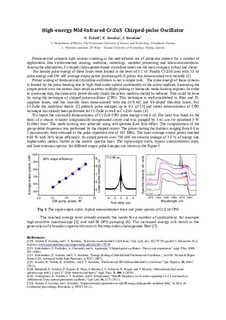| dc.contributor.author | Tolstik, Nikolai | |
| dc.contributor.author | Sorokin, Evgeni | |
| dc.contributor.author | Sorokina, Irina T | |
| dc.date.accessioned | 2017-11-23T08:18:50Z | |
| dc.date.available | 2017-11-23T08:18:50Z | |
| dc.date.created | 2017-11-02T01:24:13Z | |
| dc.date.issued | 2013 | |
| dc.identifier.isbn | 978-1-4799-0594-2 | |
| dc.identifier.uri | http://hdl.handle.net/11250/2467674 | |
| dc.description.abstract | Femtosecond coherent light sources emitting in the mid-infrared are of particular interest for a number of applications like environmental sensing, medicine, metrology, material processing and telecommunications. Among the alternatives, Cr-doped chalcogenide-based crystalline lasers are the most compact, robust and cheap.For decade pulse energy of these lasers were limited at the level of 1-2 nJ. Finally Cr:ZnS laser with 3.8 nJ pulse energy and 550 mW average output power producing 69-fs pulses was demonstrated very recently [1]. Power scaling of femtosecond crystalline oscillators is not a simple task. The pulse energy of these systems is limited by the pulse breakup due to high third-order optical nonlinearity of the active medium. Increasing the output power over the certain limit result in either multiple-pulsing or harmonic mode-locking regimes. In order to overcome that, the intracavity power density inside the active medium should be reduced. That could be done by using the technique of chirped-pulse-oscillator (CPO). This technique is well-established in fiber and Tisapphire lasers, and has recently been demonstrated with the Cr:YAG and Yb-doped thin-disk lasers. For Cr:ZnSe the analytical theory [2] predicts pulse energies up to 0.5 μJ [3] and initial demonstration of CPO technique has already been performed for Cr:ZnSe as well as Cr:ZnS lasers [4]. We report the successful demonstration of Cr:ZnS CPO pulse energy over 8 nJ. The laser was build on the basis of a classic 4-mirror astigmatically-compensated cavity and was pumped by 1.61 μm cw polarized 5-W Er:fiber laser. The mode-locking was achieved using soft-aperture Kerr lens effect. The compensation of the group-delay dispersion was performed by the chirped mirror. The pulses having the duration ranging from 0.8 to 2 picoseconds were obtained at the pulse repetition rate of 105 MHz. The laser average output power reached 0.88 W with 26% slope efficiency. At output powers over 750 mW we observe leakage of 3-5 % of energy into higher-order modes, visible as the narrow spectral lines. The input-output curve, typical autocorrelation trace, and laser emission spectra for different output pulse energies are shown in the Figure 1. | nb_NO |
| dc.language.iso | eng | nb_NO |
| dc.publisher | IEEE | nb_NO |
| dc.relation.ispartof | CLEO/Europe 2013 Technical digest | |
| dc.title | High-energy Mid-Infrared Cr:ZnS Chirped-pulse oscillator | nb_NO |
| dc.type | Chapter | nb_NO |
| dc.type | Peer reviewed | nb_NO |
| dc.description.version | acceptedVersion | nb_NO |
| dc.identifier.doi | 10.1109/CLEOE-IQEC.2013.6801057 | |
| dc.identifier.cristin | 1510083 | |
| dc.relation.project | Norges forskningsråd: 219686 | nb_NO |
| dc.description.localcode | © 2017 IEEE. Personal use of this material is permitted. Permission from IEEE must be obtained for all other uses, in any current or future media, including reprinting/republishing this material for advertising or promotional purposes, creating new collective works, for resale or redistribution to servers or lists, or reuse of any copyrighted component of this work in other works. This is the authors' accepted and refereed manuscript to the article. | nb_NO |
| cristin.unitcode | 194,66,20,0 | |
| cristin.unitname | Institutt for fysikk | |
| cristin.ispublished | true | |
| cristin.fulltext | postprint | |
